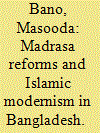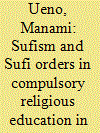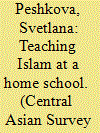|
|
|
Sort Order |
|
|
|
Items / Page
|
|
|
|
|
|
|
| Srl | Item |
| 1 |
ID:
155053


|
|
|
|
|
| Summary/Abstract |
This article examined, for the first time, religiously observant female dance teachers who take part in shaping a new path in dance instruction in a Jewish religious spirit within the Israeli general-religious education system. The article examined the connections between the teachers’ perceptions and positions on aspects related to their professional world, and between their commitment to, and satisfaction from, teaching. A total of 119 teachers participated in the study. The findings show that a predictor for satisfaction and commitment is the perception of reciprocation between teacher and the teaching profession, while commitment is also predicted by the intrinsic personal motivations.
|
|
|
|
|
|
|
|
|
|
|
|
|
|
|
|
| 2 |
ID:
122069


|
|
|
|
|
| Publication |
2013.
|
| Summary/Abstract |
Maayan Hahinuch Hatorani is a Haredi (ultra-Orthodox) educational network for elementary aged children in Israel, founded by Shas, a Sephardi ultra-Orthodox political party. The network's beginnings were in the second half of the 1980s, during the Shas' first Knesset term. It then consisted of around 30 small Talmudei Torah (Haredi elementary schools for boys), set up independently by Sephardi Haredi educational activists. This article describes their motives and activities in establishing schools for the Mizrahi community and explains the decisive contribution of two additional factors to the establishment of Maayan Hahinuch Hatorani: the senior Sephardi rabbis who awarded religious legitimacy, and the Shas Movement which provided political and financial support.
|
|
|
|
|
|
|
|
|
|
|
|
|
|
|
|
| 3 |
ID:
132963


|
|
|
|
|
| Publication |
2014.
|
| Summary/Abstract |
The old project of modernizing madrasas has acquired a new zeal in South Asia after September 2011, whereby madrasa reform programmes became an acknowledged soft tactic of the war on terror. With 9000 Aliya (reformed) madrasas, the Bangladesh madrasa modernization programme has been identified as a potentially useful model for the neighbouring states of Pakistan and India who have made slower progress in implementing similar programmes. In this paper I argue that, although the Aliya madrasa system in Bangladesh has succeeded in integrating secular subjects in the madrasa curriculum, in reality this modernization project has failed in its underlying ambition to generate a 'modern discourse' on Islam-a discourse that is compatible with the demands of western modernity. The right to speak for Islam is still primarily exercised by the 'ulama and graduates of the Qoumi (unreformed) madrasas. Aliya madrasas today compete with the secular schools not with Qoumi madrasas. The growth of the Aliya madrasa system in Bangladesh, instead of bearing testimony to the popular appeal of the modernization agenda, demonstrates the preference of Muslim parents for increased Islamic content in the school curriculum
|
|
|
|
|
|
|
|
|
|
|
|
|
|
|
|
| 4 |
ID:
134140


|
|
|
|
|
| Publication |
2014.
|
| Summary/Abstract |
The author tells us how the Islamic Institute of Tajikistan (until 2007, the Tajik Islamic University) was set up and is developing; he follows the far-from-easy road the official religious education system has covered as part of the process of Islamic revival that began as soon as the country became independent. He also looks at the moving forces and stages of the development of the official higher religious education system in Tajikistan, the key figures involved, and the problems caused by the remnants of the Soviet anti-religious past.
He identifies the main problems-lack of qualified teachers and textbooks-as well as the main obstacle, viz. defects of management and organization of the teaching process and funding, as well as clashes between the traditional and modern principles and methods for teaching religious disciplines.
Much attention is paid to the role of the state in developing official religious education as part of Tajikistan's education system.
The author traces the stages that finally brought the Islamic Institute of Tajikistan under the patronage of the state, a process that transformed the non-state religious educational establishment into a state educational institution.
|
|
|
|
|
|
|
|
|
|
|
|
|
|
|
|
| 5 |
ID:
131782


|
|
|
|
|
| Publication |
2014.
|
| Summary/Abstract |
During the nineteenth century, many Sino-Muslim scholars were seeking a more robust relationship with their Arab co-religionists. The efforts of Ma Dexin ??? (1794-1874) exemplify this shift to strengthen ties with the Muslim community outside China and situate Sino-Islamic scholarship in widespread Islamic discourses. Ma's writings provided Sino-Muslims with discursive and pragmatic tools for engaging a global Muslim community. For Ma, Muslim cooperation was negotiated through the means of religious education, which was enabled through travel and language. In this paper, I demonstrate how Ma Dexin modelled the importance of global connections of inter-Asian networks of religious learning by exemplifying the value of Middle Eastern travel and fluency in Arabic. I employ Ma's Chinese and Arabic written works in relation to those of Wang Daiyu ??? (circa 1590-1658) and Liu Zhi ?? (circa 1670-1724) to illustrate how he differed significantly from previous Sino-Muslim authors with regard to the use of Arabic within the Sino-Islamic intellectual tradition and in his emphatic urgings to perform the hajj pilgrimage. Finally, I briefly show how his divergent position was embraced, as exhibited through the efforts of one of his intellectual inheritors, Ma Lianyuan ??? (1841-1903).
|
|
|
|
|
|
|
|
|
|
|
|
|
|
|
|
| 6 |
ID:
106286


|
|
|
|
|
| Publication |
2011.
|
| Summary/Abstract |
This article examines the complex relationship between the Islamic movement and a set of religious schools that are known as the Imam-Hatip schools in Turkey. To this end, it focuses on Hayrettin Karaman, a revered Muslim intellectual with close ties to the schools and their communities. The article presents Karaman's ideas and analyzes his writings to demonstrate how he envisions Imam-Hatip schools and their communities becoming the cornerstones of Turkey's Islamization process. An analysis of Hayrettin Karaman illustrates the extent to which Islamic schools in Turkey comprise an integral part of the substantial network of people and institutions that advance the Islamic cause.
|
|
|
|
|
|
|
|
|
|
|
|
|
|
|
|
| 7 |
ID:
159335


|
|
|
|
|
| Summary/Abstract |
The governments of the Turkish Republic have claimed the authority to decide what kind of Islam is or is not desirable for Turkish citizens. This article explores how the governments after the 1980 coup infiltrated the negative image of Sufi orders into compulsory religious education and how the Justice and Development Party regime has been trying to modify it. To do so, it investigates the descriptions of Sufi orders as well as Sufism in the textbooks studied as part of the mandatory Religious Culture and Morals course from the beginning of 1982 to present.
|
|
|
|
|
|
|
|
|
|
|
|
|
|
|
|
| 8 |
ID:
128704


|
|
|
|
|
| Publication |
2014.
|
| Summary/Abstract |
In this article I describe and analyse non-institutionalized religious education among local women in Uzbekistan. I argue that while exhibiting vestiges of 'traditional' objectives, methods of teaching, and models of knowledge transmission, and incorporating elements of educational reforms advocated by the Central Asian reformers in the early 1900s, and of Soviet pedagogy, the dynamics of such education foster students' critical thinking. By enabling students to think critically about their lives and social environment, the non-institutionalized religious education does not have one predetermined outcome, but ensures social change that starts on an individual level, whereby a student can, but does not have to, engage politically with the state, which systematically intervenes in shaping its citizens' religious lives.
|
|
|
|
|
|
|
|
|
|
|
|
|
|
|
|
|
|
|
|
|